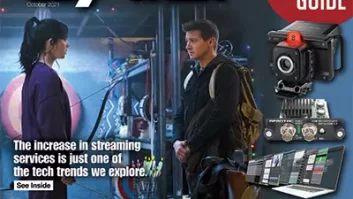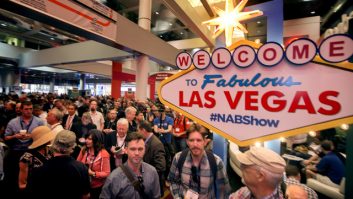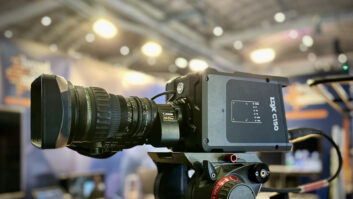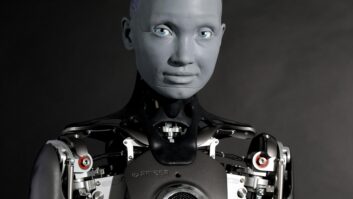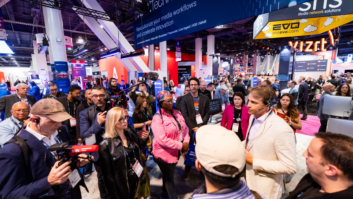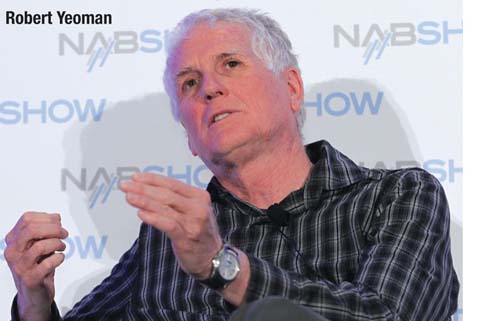
Award-winning cinematographer Robert Yeoman, ASC, told a Monday session of the Creative Master Series that one of the more gratifying and challenging aspects of working with Wes Anderson on The Grand Budapest Hotel was dealing with no fewer than three aspect ratios — 1.37:1, 1.85:1 and anamorphic.
Film over digital continues to be the preference of choice for both Yeoman and Anderson, who have collaborated on seven motion pictures, including The Grand Budapest Hotel, which was nominated for the Best Picture Oscar for 2014. In a conversation with host Jon D. Witmer, managing editor of American Cinematographer, Yeoman said it was Anderson who came up with the concept of using different aspect ratios to indicate different time periods in the film, including the older 1.37.1, which was a favorite aspect ratio for motion pictures until the early 1950s.
While filming most exterior and some interior scenes for The Grand Budapest Hotel in Dresden and other locales in Germany (to represent the fictitious Republic of Zubrowka), Yeoman said deploying 1.37:1 necessitated “a whole different way to approach composition. But Wes and I got into it pretty quickly. We had, among other things, familiarised ourselves with the works of previous productions. [But] it was a challenge. If we had done The Royal Tenenbaums [2001] now, it may have been shot in 1.37:1,” Yeoman said, because today’s digital post-production tools make using various aspect ratios far easier than in the analogue world.
Yeoman said every Wes Anderson movie he works on includes a detailed storyboarding for each scene, and he and the very non-traditional director are so much on the same wavelength on the set that Anderson will often tell an actor if he or she is slightly off their mark, rather than have Yeoman himself “do the dirty work” as the director of photography, he said to laughter from the standing-room-only crowd in a session produced in partnership with the American Society of Cinematographers and American Cinematographer magazine.
Along with old photographs of European hotels and other archival resources, Yeoman said another big influence on The Grand Budapest Hotel project shot on Kodak film was the 1966 Alfred Hitchcock thriller Torn Curtain starring Paul Newman and Julie Andrews. The team loved the “front projection” sequences in the Hitchcock film — an approach deployed in one of the key scenes in The Grand Budapest Hotel whose large assemble cast includes Ralph Fiennes, Willem Dafoe, Jeff Goldblum, Tilda Swinton, Adrien Brody, Bill Murray, Jude Law, Owen Wilson and Saoirse Ronan, among others.
Unlike with most of his other Wes Anderson collaborations, Yeoman found himself working on another film project in England and not able to participate as much as usual in the post-production process on The Grand Budapest Hotel. But he was grateful he was given the opportunity to provide his input to an initial cut of the film and said he’s very pleased with the final product.
Yeoman said the film format he loves best is not 35mm, although he still generally prefers 35mm over digital for now, depending on the project. “I just love Super 16. It can just do things differently than 35mm or digital.” And a recent Yeoman/Anderson project, Moonrise Kingdom (2012) was filmed in Super 16. Still, the veteran cinematographer is not averse to digital, in principle. In fact, the upcoming June comedy Spy directed by Paul Feig and starring Melissa McCarthy and Jason Statham will be Yeoman’s first all-digital production. “I worked with the Alexa and I was quite happy with it. In some darker scenes, especially, the Alexa performed beautifully,” Yeoman concluded.
By John Merli, Digital Video
All content courtesy of NAB Daily, under copyright: © 2015 NAB
